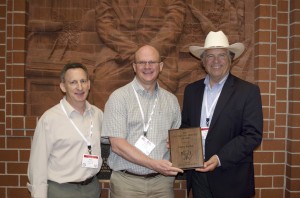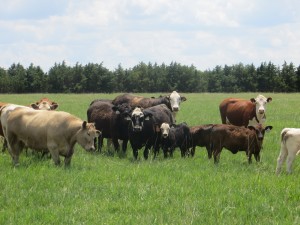
Nice to Meat Ya: Larry Kuehn
First, we as writers must understand, to then help thousands of readers also understand. Larry makes it understandable.

But when I say that the U.S. Meat Animal Research Center (MARC), part of the USDA Agricultural Research Service, is fortunate to have this geneticist on staff, he’d quickly point out that he’s also lucky to be there.
At Clay Center, Neb., Larry works just 40 miles from the diversified farm he grew up on, where raking hay and processing calves shaped his career path. As a matter of fact, they almost were his career path.
As he headed off to a local community college, Larry planned to return to the farm, but upon graduation he felt the University of Nebraska-Lincoln animal science program calling. He thought he’d return to feedlot chores and the cow-calf herd in a few more years.
Around the time he was finishing at Nebraska the cattle market took a big hit.
“The profit opportunities suddenly didn’t look so good to go back,” Larry says.

Now he can hardly imagine a job that wasn’t divided between computer time spent analyzing data, and being outside, taking weaning notes or making phenotypic observations, for example.
For the last eight years, his main appointment has been working on the Germplasm Evaluation Program with colleagues Mark Thallman and Warren Snelling, continuing on the work started decades ago by some of the legends who came before him.
That’s not to say he’s doing what they did back in the ‘60s when they evaluated many of the “exotics” to help understand breed strengths and weaknesses.
“Today we’re trying to stay current,” Larry says of the annual samplings of the most popular breeds and bulls within those breeds.
“I really enjoy being able to work on the design part and then see it through to completion,” he says.

He looks ahead to exciting possibilities, like a DNA test that could predict disease resistance or being able to individually manage animals based on their specific genetic makeup, but the practical scientist is still very interested in the application of what he sees here and now.
“Breeds generally try to race each other toward the same goals rather than rely on their strengths,” Larry says, noting that the maximum growth doesn’t always equal the maximum profit.
MARC provides across-breed EPDs for economically important traits and also works to find associations with DNA markers.
But all of the data is virtually useless if you can’t get producers to use it. That’s why Larry enjoys the producer outreach part of his job, too, and relies on his farm upbringing to help in translation. Even he admits that complex statistics and chemistry can be difficult topics.
“It’s a good test if you can explain the process,” he says. “It’s a fun puzzle.”
And the fact that he thinks so, certainly makes it easier for someone like me (and probably you, too).
May your bottom line be filled with black ink,
Miranda
PS–To catch up on all the other “unsung heroes” we’ve covered this month, check out these links:
- Introduction: Nice to Meat Ya
- Day 1: Ashley Pado
- Day 2: Scott Redden
- Day 3: Jesse Stucky
- Day 4: Bridget Wasser
- Day 5: Amanda Barstow
- Day 6: Josh Moore
- Day 7: Ruth Ammon
- Day 8: Bill Tackett
- Day 9: Dan Chase
- Day 10: Danielle Foster
- Day 11: Eric Mihaly
- Day 12: Jennifer Kiko
- Day 13: Mark Morgan
- Day 14: Meg and Matt Groves
- Day 15: Rod Kamph
- Day 16: Jonnie Schreffler
- Day 17: Brent Eichar
- Day 18: Alberto Diaz
You may also like
Progress from small steps
Every day is a chance to learn and get better. Thousands of others like my new friends in Alabama are taking steps to meet the shifts in consumer demand, and to know more. Small steps in the right direction can start now. Even if it’s just recording a snapshot of where you are today, a benchmark for tomorrow.
Not perfect, but working to get better
The CAB Cattleman Connection team heard its name called more than once in the virtual ceremonies, and each time came a sense of personal accomplishment, but even better: confirmation that we’re getting better at our craft. I hope that means we’re doing a better job for you.
Beefed up findings
Frank Mitloehner presents his findings on the animal ag sector’s impact on global warming. He explains how cattle counterbalance other fossil fuel sectors, proving that cattle are a solution and not a threat.



